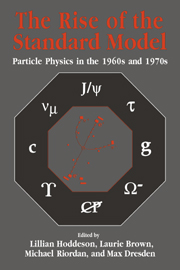Book contents
- Frontmatter
- Contents
- Contributors
- Editors' Acknowledgments
- Photographs of the Symposium
- Abbreviations and Acronyms
- Mathematical Notation
- Part One Introduction
- Part Two Quarks and Leptons
- Part Three Toward Gauge Theories
- Part Four Accelerators, Detectors, and Laboratories
- Part Five Electroweak Unification
- 23 The First Gauge Theory of the Weak Interactions
- 24 The Early History of High-Energy Neutrino Physics
- 25 Gargamelle and the Discovery of Neutral Currents
- 26 What a Fourth Quark Can Do
- 27 Weak-Electromagnetic Interference in Polarized Electron–Deuteron Scattering
- 28 Panel Session: Spontaneous Breaking of Symmetry
- Part Six The Discovery of Quarks and Gluons
- Part Seven Personal Overviews
- Index
23 - The First Gauge Theory of the Weak Interactions
Published online by Cambridge University Press: 03 February 2010
- Frontmatter
- Contents
- Contributors
- Editors' Acknowledgments
- Photographs of the Symposium
- Abbreviations and Acronyms
- Mathematical Notation
- Part One Introduction
- Part Two Quarks and Leptons
- Part Three Toward Gauge Theories
- Part Four Accelerators, Detectors, and Laboratories
- Part Five Electroweak Unification
- 23 The First Gauge Theory of the Weak Interactions
- 24 The Early History of High-Energy Neutrino Physics
- 25 Gargamelle and the Discovery of Neutral Currents
- 26 What a Fourth Quark Can Do
- 27 Weak-Electromagnetic Interference in Polarized Electron–Deuteron Scattering
- 28 Panel Session: Spontaneous Breaking of Symmetry
- Part Six The Discovery of Quarks and Gluons
- Part Seven Personal Overviews
- Index
Summary
The electroweak sector of the Standard Model contains three logically and historically distinct elements:
1. A chiral gauge theory of weak interactions with an exact SU(2)L symmetry;
2. The Higgs mechanism for spontaneous symmetry breaking, giving some of the gauge bosons finite masses, while maintaining renormalizability;
3. Electroweak unification through W0—B0 mixing by sin θw.5
This report is concerned with the early history of the electroweak sector of the Standard Model. I first recall the history of gauge theories in the 1950s and my own motivation for publishing the first chiral gauge theory of weak interactions, predicting weak neutral currents of exact V–A form and approximately the weak strength observed fifteen years later. Then I discuss the evolving appreciation of the fundamental distinctions between global and gauge, partial and exact symmetries, in the weak and strong interactions. Finally, I emphasize that exact gauge symmetry is necessary for the Higgs mechanism for symmetry breaking, but that electroweak unification is not required theoretically: Within the Standard Model, the electroweak mixing angle, sinθw, is not determined, but could have any value, including zero. This leads to an interesting difference between the sin θw = 0 limit of the unified electroweak theory and the original SU(2)w gauge theory of weak interactions alone.
Theoretical consistency requires that a field theory be renormalizable, not necessarily unified.
- Type
- Chapter
- Information
- The Rise of the Standard ModelA History of Particle Physics from 1964 to 1979, pp. 403 - 410Publisher: Cambridge University PressPrint publication year: 1997



